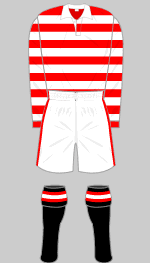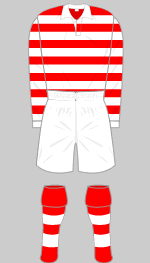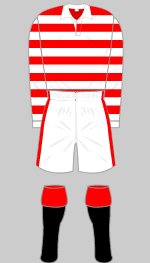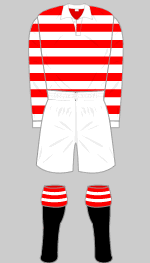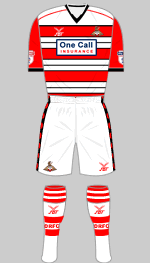


Doncaster
Rovers
Formed 1879
Elected to Division Two 1901. Failed re-election 1903.
Elected to Division Two 1904. Failed re-election 1905.
Elected to Division Three (North) 1923. Relegated to the Conference 1998.
Promoted from the Conference to Division Three 2003.
Kit History
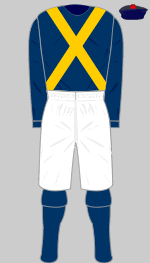
1879 a o
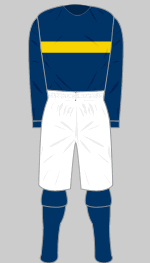
1881 v
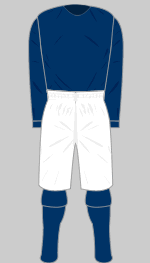
1883-1884 i
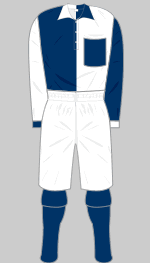
1884-1885 b i s
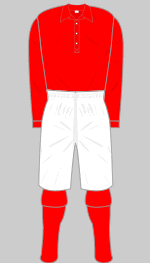
1885-1890 i v
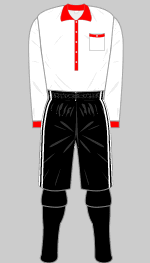
1890-1891 o
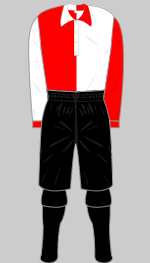
1895-1897 b
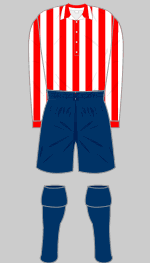
1900-1901 d h
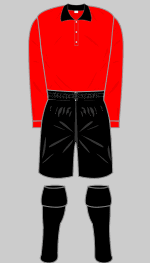
1901-1902 o
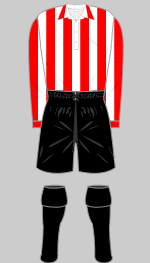
1902-1903 o
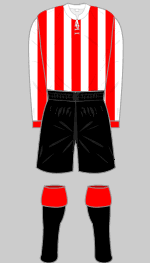
1904-1905 o
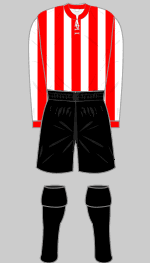
1905-1909 d h
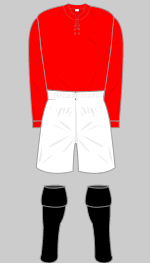
1909-1911 o
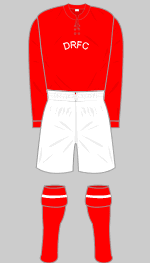
1911-1912 b o
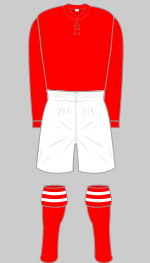
1912-1920 b i
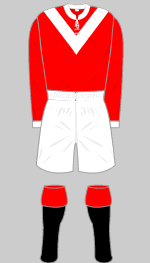
1920-1921 b o

1921-1922 o
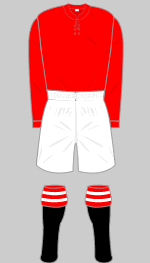
1922-1924 b o
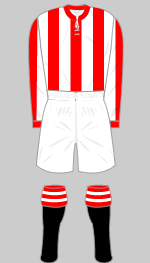
1924-1927 o u

1927-1930 b i o
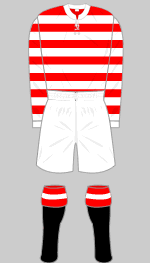
1930-1932 o
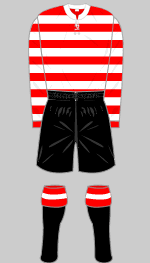
1931-1932 alt o

1932-1933 b i
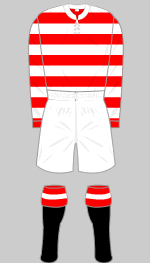
1933-1935 o
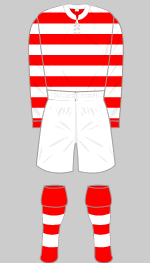
1935-1936 o

1936-1937 b o
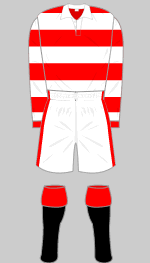
1945-1946 o
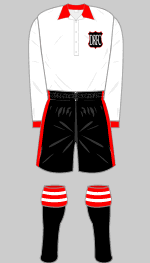
Autumn 1948 o

1950-1951 b o
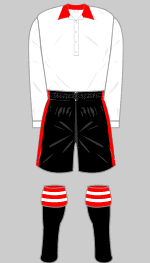
1951-1952 o
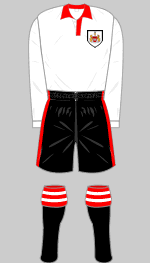
1952-1953 b o
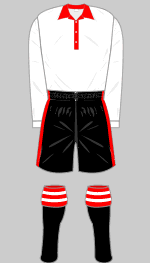
circa March 1953 o

1953-1955 b i o
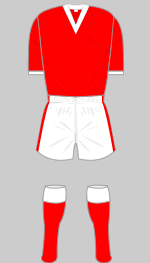
1955-1956 p
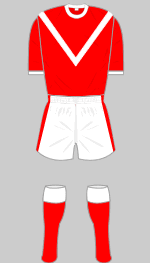
1956-1957 b o p
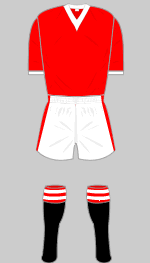
1957-1958 b o
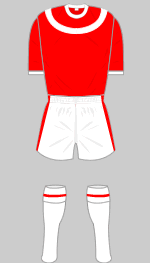
1958-1959 b w

1959-1960 b
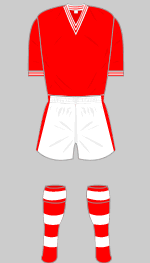
1960-1961 i o

1961-1962 b

1962-1963 b o
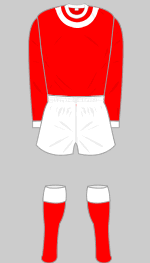
May 1963 e o
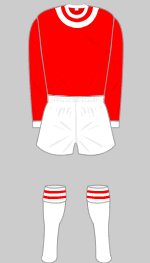
Aug-Dec 1963 b o
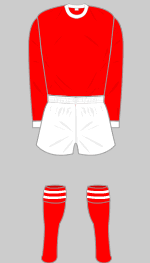
Dec 1963-1965 b o
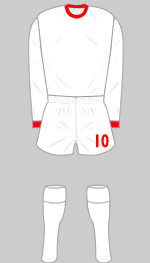
1965-1966 b
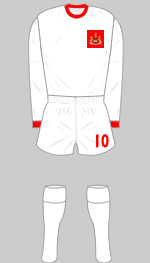
1966-1967 o
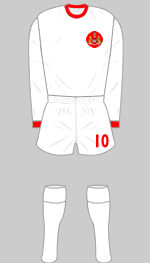
1967-1969 b n
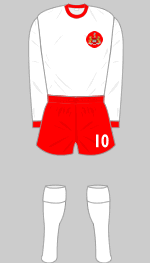
1969-1970 f g
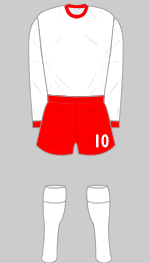
1970-Jan 1971 o
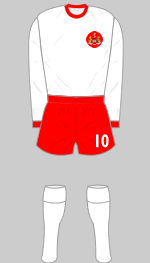
Jan 1971-1972 o
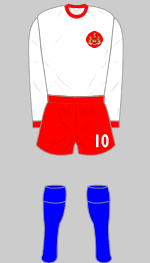
1971-1972 alt o
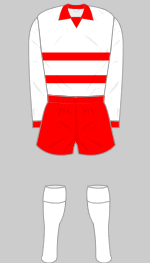
1972-1974 f i m n
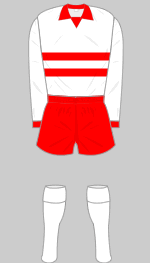
1974-1975 o
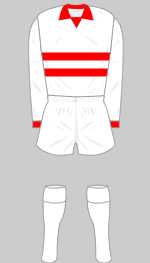
1974-1975 alt o
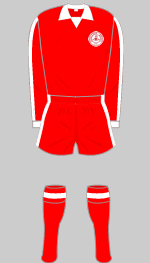
1975-1976 b i m o
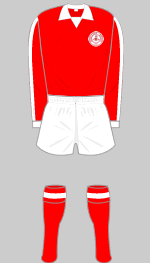
1976-1977 o
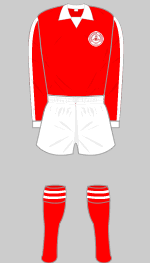
1977-1978 b m o
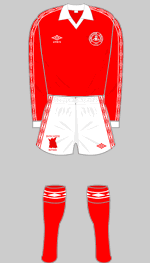
1978-1979 b m o

1979-1981 b o
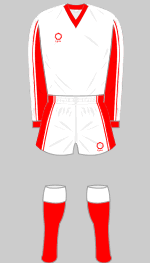
1981-1982 i o

1982-1983 i o
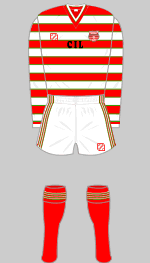
Sept-Dec 1983 b o
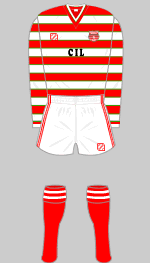
Dec 1983-1984 o
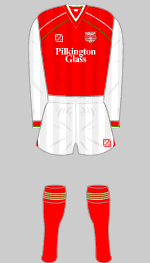
1984-1987 b o

1987-1988 b o
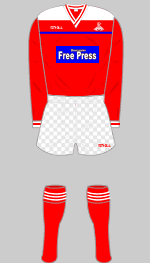
1988-1989 b i o
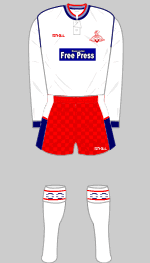
1989-1990 b o

1990-1991 b i o

1991-1992 o
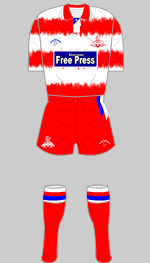
1992-1993 b o
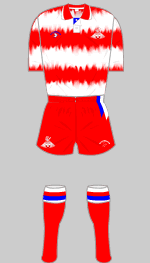
Aug-Sept 1993 o
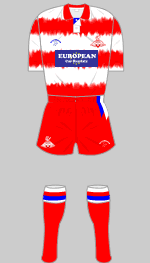
Oct 1993-1994 b
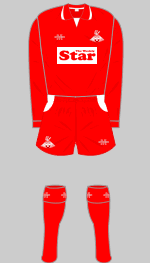
1994-1995 b o

Aug-Dec 1995 k o
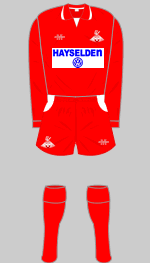
Dec 95-1996 k o
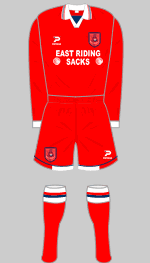
1996-1997 b

Aug-Sept 1997 o
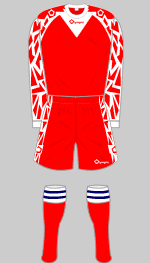
Aug-Sept 1997 alt o
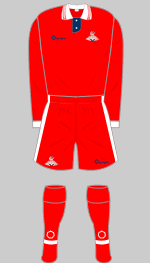
Oct 97-Apr 98 k o
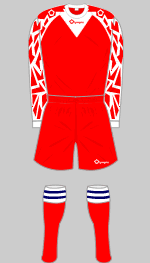
May 1998 b o
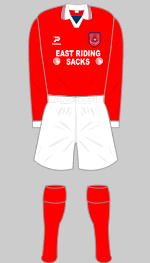
Aug 1998 o
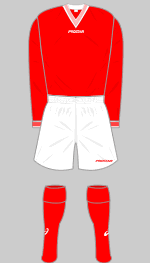
Aug-Sept 1998 o
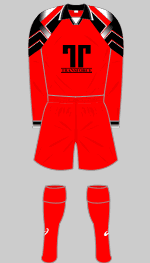
Sept 1998 o q
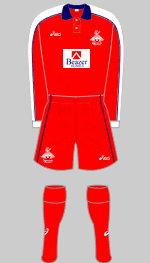
Oct '98-May '99 b g o

1999-2000 l o
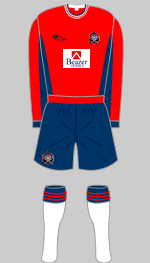
2000-2001 b g j o
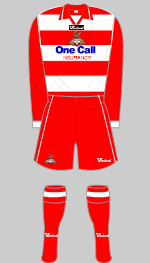
2001-2002 g o
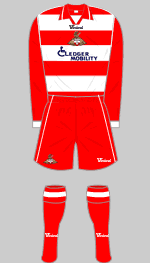
2002-2003 g o
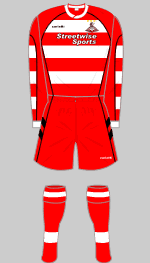
2003-2005 c
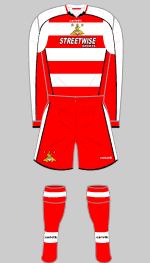
2005-2006 c o
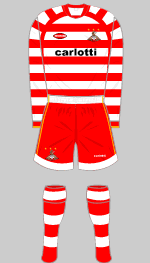
2006-2007 c j o
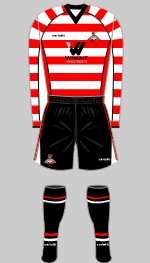
2007-2008 c
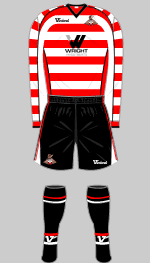
2008-2009 r
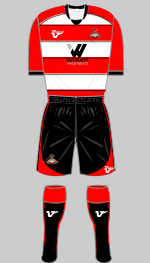
2009-2010 c

2010-2011 c
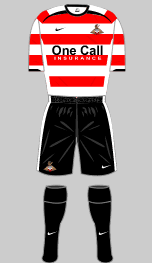
2011-2012 c
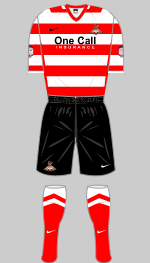
2012-2013 c
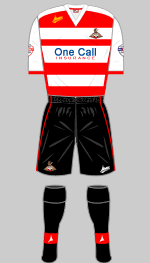
2013-2014 c
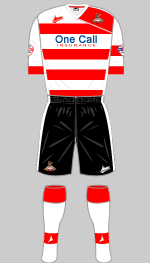
2014-2015 c t
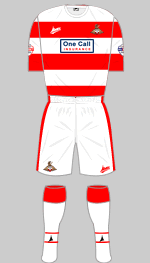
2015-2016 c
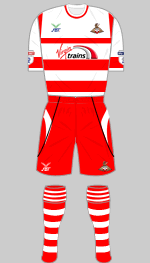
Aug-Dec 2017 c
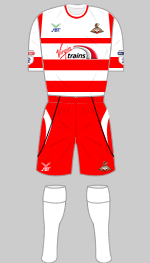
Dec 17-May 18 c
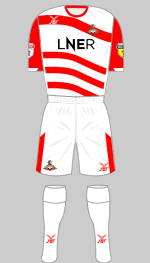
2018-2019 c
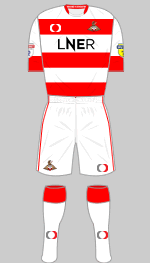
2019-2020 c
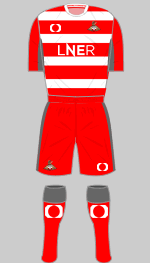
2020-2021 c
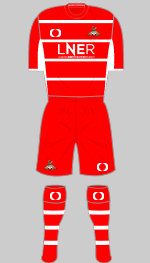
2021-2022 c
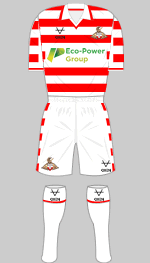
2022-2023 c
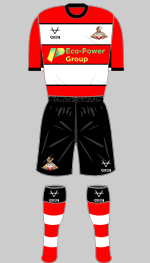
2023-2024 c
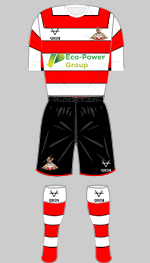
2024-2025 c
Background
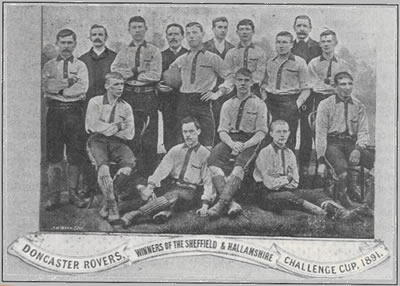 In 1879 a group
of young apprentices from the Great Northern Railway Works in Doncaster organised
a football game against the Yorkshire Institute for the Deaf & Dumb, wearing unusual blue jerseys with yellow cross bands and blue Tam o' Shanters with red tassels.
They enjoyed themselves so much that they decided to form a club to be
known as Doncaster Rovers. According to the Official History the club wore blue and white between 1883 and 1885. After six years of playing
wherever they could, the club took up residence on the Intake Ground and
adopted scarlet jerseys in 1885-86. In 1888 Rovers
entered the FA Cup and were trounced 1-9 at home by Rotherham Town. In
1890 the club became founder members of the Midland Alliance and in 1891
they were elected to the Midlands League. After winning the championship
in 1897 and 1899, Rovers were elected to the Second Division of the Football
League in 1901, replacing New Brighton Tower. In 1903 Rovers finished
sixteen out of eighteen and were forced to apply for re-election. To their
dismay, they were voted out in favour of Yorkshire rivals Bradford City.
In 1879 a group
of young apprentices from the Great Northern Railway Works in Doncaster organised
a football game against the Yorkshire Institute for the Deaf & Dumb, wearing unusual blue jerseys with yellow cross bands and blue Tam o' Shanters with red tassels.
They enjoyed themselves so much that they decided to form a club to be
known as Doncaster Rovers. According to the Official History the club wore blue and white between 1883 and 1885. After six years of playing
wherever they could, the club took up residence on the Intake Ground and
adopted scarlet jerseys in 1885-86. In 1888 Rovers
entered the FA Cup and were trounced 1-9 at home by Rotherham Town. In
1890 the club became founder members of the Midland Alliance and in 1891
they were elected to the Midlands League. After winning the championship
in 1897 and 1899, Rovers were elected to the Second Division of the Football
League in 1901, replacing New Brighton Tower. In 1903 Rovers finished
sixteen out of eighteen and were forced to apply for re-election. To their
dismay, they were voted out in favour of Yorkshire rivals Bradford City.
The club spent the next season in the Midland League
and applied for election back to the Football League at the end of the
1903-04 season. They achieved 21 votes, enough to replace Stockport County
who only received 11. The season was catastrophic, however, and Rovers
finished rock bottom with a mere 8 points. They were voted out once more
and although they had a second chance when another ballot was called to
fill four vacancies in the expanded Second Division, they finished bottom
of the poll. So it was back to the Midlands League and obscurity.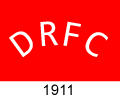
The first "crest" worn by the team appeared in 1911-12 when the club's initials were embroidered onto the centre of the shirt in large lettering.
In August 1914 the club went into liquidation but
a new company was formed almost immediately and took over the formers
club's fixtures. When professional competition was suspended in 1915,
the club closed down and the Intake Ground was taken over by the Army
and used as a military depot. In the summer of 1920 Rovers were revived
but were without a home ground as the Army were still using their former
home. With the help of Doncaster Corporation, a new ground was built and
named Belle Vue. Rovers application to the new Third Division (North)
in 1921 was not 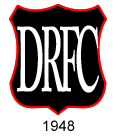 successful but in 1923 the division was expanded and this
time Doncaster's application was accepted.
successful but in 1923 the division was expanded and this
time Doncaster's application was accepted.
In 1935, now wearing hooped shirts, Rovers were
promoted to the Second Division where they lasted two seasons before being
relegated. Immediately after the Second World War, the club won the Third
Division (North) championship twice (1947, 1950 - they were relegated
in 1948) and became established in the middle of the Second Division.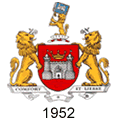
In the 1948-49 season, the team often wore white shirts at home during the autumn while their normal hooped tops were used at other times. The new shirts had "DRFC" embroidered onto a black shield edged in red. In 1950 Rovers adopted 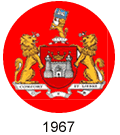 white shirts as their official first choice but with the lettering appearing out of a red shield edged in black. This was briefly replaced in 1952-53 with the Doncaster coat of arms.
white shirts as their official first choice but with the lettering appearing out of a red shield edged in black. This was briefly replaced in 1952-53 with the Doncaster coat of arms.
Successive relegations in 1958 and 1959 took Rovers back down to the Fourth Division and in 1962 they had to apply for re-election. During the late 1960s Rovers twice won the Fourth Division title (1966 and 1969) but were relegated soon afterwards.
The town coat of arms reappeared in 1966 on a red rectangle and then, from 1967 to 1972, on a red disc.
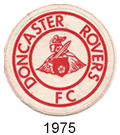
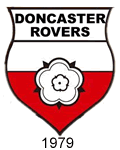 Throughout the 1970s Doncaster were firmly
stuck in the lowest division. The familiar viking crest appeared for the first time in 1972 on programme covers and then on players' shirts in 1975. The commonly accepted story behind the new design is that the manager of the time, Maurice Setters, was casting about for a new design when an advertisement for Rover cars caught his eye. Although it has not been possible to verify this story it seems plausible as Doncaster is not known for having Viking connections (it was in fact a minor Roman garrison town).
Throughout the 1970s Doncaster were firmly
stuck in the lowest division. The familiar viking crest appeared for the first time in 1972 on programme covers and then on players' shirts in 1975. The commonly accepted story behind the new design is that the manager of the time, Maurice Setters, was casting about for a new design when an advertisement for Rover cars caught his eye. Although it has not been possible to verify this story it seems plausible as Doncaster is not known for having Viking connections (it was in fact a minor Roman garrison town).
In 1979 a smart new crest (without the viking) was designed to go with Rovers' new white Sereena strips. This was replaced in 1982 when 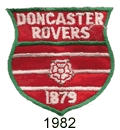 Hobott took over as the club's kit provider and added green as an accent colour.
Hobott took over as the club's kit provider and added green as an accent colour.
During the 1980s Rovers had two spells in
the Third Division but in 1988 they were 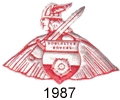 relegated back to Division Four. The viking crest was revived in 1987 and became firmly established as the supporters' favourite, appearing on the various combinations of red and white worn over the following nine seasons.
relegated back to Division Four. The viking crest was revived in 1987 and became firmly established as the supporters' favourite, appearing on the various combinations of red and white worn over the following nine seasons.
Prior to the 1996-97 season, the club had planned to wear the Doncaster borough crest and 2,000 were made up but had to be discarded when the 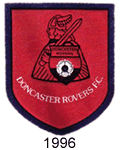 council objected. A club official drew a rough sketch of the Viking badge and the result was the rather poorly designed badge shown here on the left.
council objected. A club official drew a rough sketch of the Viking badge and the result was the rather poorly designed badge shown here on the left.
During Rover's disastrous 1997-98 campaign the crest only appeared for part of the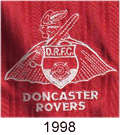 season at the end of which they finished bottom of the League and
were relegated to the Conference, the third time they had lost League
status. The familiar viking returned in October 1998 picked out in white and with the club's name underneath. This was replaced the following season by a full colour version.
season at the end of which they finished bottom of the League and
were relegated to the Conference, the third time they had lost League
status. The familiar viking returned in October 1998 picked out in white and with the club's name underneath. This was replaced the following season by a full colour version.
Between 1999 and 2001 the club produced kits under it's own "Viking Leisurewear" brand. The second of these introduced a brand new crest of obscure design. The only link with 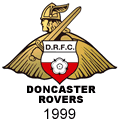 previous versions was the inclusion of the Yorkshire rose.
previous versions was the inclusion of the Yorkshire rose.
When Vandanel took over as kit supplier in 2001, they introduced hooped shirts recalling Rovers' pre-war heritage. Furthermore the 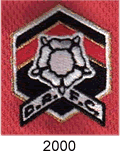 popular viking crest was reinstated: this was identical to the 1999 version but with "Doncaster Rovers" omitted.
popular viking crest was reinstated: this was identical to the 1999 version but with "Doncaster Rovers" omitted.
After five seasons in the Conference, Rovers became
the first club to gain promotion to the League via the new play-offs,
going on to win the Nationwide Division Three title at the first attempt. In May 2008 Doncaster reached the play-off final where they unexpectedly beat Leeds United to earn 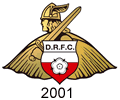 a place in The Championship, England's second tier. They remained at this level until relegated in 2012. The following season, however, in a thrilling climax to the season, they clinched the League One title with a win at Brentford in their final game. In 2016 they dropped back into League Two but bounced back straight away but in 2021 they were again relegated.
a place in The Championship, England's second tier. They remained at this level until relegated in 2012. The following season, however, in a thrilling climax to the season, they clinched the League One title with a win at Brentford in their final game. In 2016 they dropped back into League Two but bounced back straight away but in 2021 they were again relegated.
I am grateful to Christopher Worrall, an authority on Doncaster's history, for his extensive input to this section.
Sources
- (a) Club Colours (Bob Bickerton)
- (b) Doncaster Rovers FC (Images of Sport: Peter Tuffrey)
- (c) Doncaster Rovers Official Website
- (d) Bjorkasen
- (e) Crewe Alexandra FC (Images of Sport - Harold Finch)
- (f) Football Cards
- (g) Alliance to Conference (John Harman 2005)
- (e) Rob Clark
- (f) Pete's Picture Palace
- (g) Football Focus
- (h) Association of Football Statisticians - provided by Pete Wyatt
- (i) Donny - The Official History of Doncaster Rovers - provided by Greger Lindberg.
- (j) Steven Holmes
- (k) David King
- (l) Charles Hirst
- (m) Alick Milne
- (n) Football League Review
- (o) Chris Worrall - HFK Research Associate
- (p) Simon Monks
- (q) Mark Holland
- (r) Football Shirt Culture
- (s) Keith Ellis
- (t) David Rafelle
- (u) Lancashire Evening Post (5 July 1924) submitted by Brian Webb
- (v) Charles Alcock's Football Annuals 1869-1891 researched by Robin Horton
- (w) seniortigers.org.uk
Crest history provided by Christopher Worrall with further background on 1996-97 from Wayne Tomlinson. Crests are the property of Doncaster Rovers FC.
